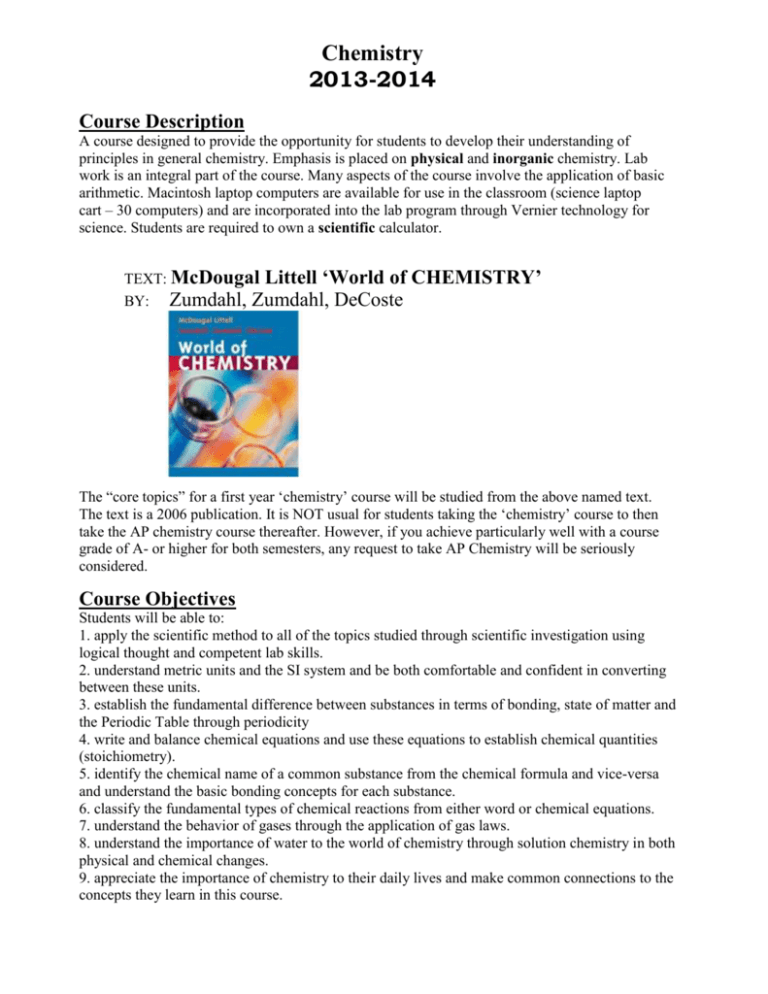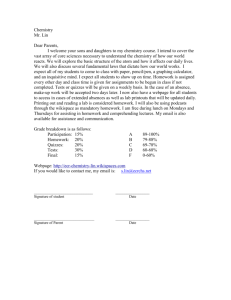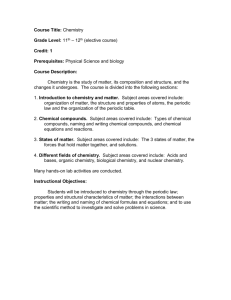Course Description
advertisement

Chemistry 2013-2014 Course Description A course designed to provide the opportunity for students to develop their understanding of principles in general chemistry. Emphasis is placed on physical and inorganic chemistry. Lab work is an integral part of the course. Many aspects of the course involve the application of basic arithmetic. Macintosh laptop computers are available for use in the classroom (science laptop cart – 30 computers) and are incorporated into the lab program through Vernier technology for science. Students are required to own a scientific calculator. TEXT: McDougal Littell ‘World of BY: Zumdahl, Zumdahl, DeCoste CHEMISTRY’ The “core topics” for a first year ‘chemistry’ course will be studied from the above named text. The text is a 2006 publication. It is NOT usual for students taking the ‘chemistry’ course to then take the AP chemistry course thereafter. However, if you achieve particularly well with a course grade of A- or higher for both semesters, any request to take AP Chemistry will be seriously considered. Course Objectives Students will be able to: 1. apply the scientific method to all of the topics studied through scientific investigation using logical thought and competent lab skills. 2. understand metric units and the SI system and be both comfortable and confident in converting between these units. 3. establish the fundamental difference between substances in terms of bonding, state of matter and the Periodic Table through periodicity 4. write and balance chemical equations and use these equations to establish chemical quantities (stoichiometry). 5. identify the chemical name of a common substance from the chemical formula and vice-versa and understand the basic bonding concepts for each substance. 6. classify the fundamental types of chemical reactions from either word or chemical equations. 7. understand the behavior of gases through the application of gas laws. 8. understand the importance of water to the world of chemistry through solution chemistry in both physical and chemical changes. 9. appreciate the importance of chemistry to their daily lives and make common connections to the concepts they learn in this course. Your Schedule Please examine your schedule and state below when this class is scheduled to meet for the three ‘theory’ classes and the one ‘lab’ class: Rotation Day# ______ Class: ______ Rotation Day# ______ Class: ______ Rotation Day# ______ Class: ______ Rotation Day# ______ Class: ______ PLEASE BE PUNCTUAL TO EVERY CLASS…..THREE TARDIES = DETENTION…and a detention for every tardy thereafter! (THIS IS A SCHOOL RULE! – SEE STUDENT HANDBOOK) What to bring to class It is necessary to bring your text to EVERY class, even labs. Please be well equipped with pencils/pens, erasers, a ruler, and a scientific calculator – the essentials! You may also feel the need to have with you some ‘white-out’, hi-light pens, or any other equipment that you feel may be useful to you. NOTE – PLEASE ENTER YOUR NAME IN YOUR TEXT, FILES AND SPIRALS. IT IS ALSO A GOOD IDEA TO WRITE YOUR NAME ON THE EDGE OF THE PAGES OF YOUR TEXT WITH A MARKER PEN ………IMPORTANT! What to write down in class You are expected to TAKE NOTES based on the details written up on the white boards, information shown to you on the screen (computer, document camera) or just verbal points that may be emphasized. Use either a ring binder or a spiral (ideally one spiral per subject). QUALITY NOTES HELP YOU IN THE REVIEW PROCESS FOR ASSIGNMENTS! Tests There will be 3 tests each semester – IMPORTANT – a major component of your final grade! Each test will be preceded by a period of time to review, which will be supplemented by review sheets and answer keys. You will be provided with a calculator (without memory) for your use with the test. The TI series calculators will NOT be permitted for use on the tests due to ‘memory’ capabilities. No room for negotiation here – sorry! Homework Homework may take different forms based on the following: 1. Each unit of study will be accompanied by ‘end of chapter’ questions from your textbook. A selection of these questions will be assigned for homework and submitted at the end of that chapter study. 2. Worksheets may be given to supplement the topics covered. 3. Reading assignments may be given to help either introduce or reinforce in-class learning. In all written homework, completion credit will be available. ….Written homework can translate into EASY COMPLETION POINTS provided the effort is put forth to complete all work FULLY in a timely manner. Some questions may be considered for specific content as part of the homework grade. ALL HOMEWORK MUST BE NEATLY PRESENTED, EITHER TYPED OR LEGIBLY WRITTEN – PLEASE NO SPIRAL-TORN EDGES. ….POINTS WILL BE DEDUCTED FOR POORLY PRESENTED WORK. Labs A full 75-minute class will be allocated each 7-day rotation for the purpose of completing lab assignments. Any remaining time after the lab is complete will be used to continue analyzing the lab, working data, establishing conclusions and other chemistry course work. There will not be any FREE TIME or EARLY DEPARTURE from lab classes when the lab activity is complete. WHEN IN THE CHEMISTRY ROOM/LAB… …NO FOOD OR DRINK (water IS allowed in the carpeted area only!) …SPECIAL CARE NEEDED WHEN WORKING WITH CHEMICALS AND FIRE: • Do not touch HOT items!...you will get burned! • Please respect ALL chemicals – some can be particularly HAZARDOUS (it is best to assume they all are!) Quizzes These will be presented to you with at least 24 hours notice. They will be anywhere between 5 and 20 minutes duration. There are two types of quizzes that will be given: CLOSED BOOK QUIZZES – based on material from the text or from information presented during class. You are expected to complete answers from memory, so be prepared! OPEN BOOK QUIZZES – based on material from lab work. You can bring in any lab handouts and data you may have collected. You can even use your textbook (or any other book) to search for answers to the questions asked. NOTE – you are expected to work by yourself on both types of quizzes. No materials can be exchanged between students during an ‘open book’ quiz – not even a textbook. Exams There will be two exams featured in this year long course. The first will be at the conclusion of the first semester (mid-December) while the second will be given at the conclusion of the second semester (May). This second exam is NOT cumulative and will therefore focus on second semester topics only (Jan. through May). However, the fundamentals learned in the first semester will carry over to some extent. NOTE – your own TI series (but not ‘QWERTY’) calculators WILL be permitted for your use. The memory function can be utilized FULLY! Syllabus The following topics are aligned with the textbook chapters, although the order in which they are covered will not exactly follow the chronological order as they appear in the book. I – Chapter 1: Chemistry: An Introduction • The Importance of Learning Chemistry • What is Chemistry • Solving Problems Using a Scientific Calculator • Using Scientific Thinking to Problem Solve • The Scientific Method • Learning Chemistry. II – Chapter 5: Measurements and Calculations • Scientific Notation • Units/Prefixes • Length, Volume & Mass • Uncertainty in Measurement • Significant Figures • Problem Solving & Dimensional Analysis • Temperature Measurements & Conversions • Density III – Chapter 2: Matter • The Particulate Nature of Matter • Elements and Compounds • The States of Matter • Physical and Chemical Changes/Properties • Mixtures and Pure Substances • Separation of Mixtures. IV – Chapter 3: Chemical Foundations – Elements Atoms and Ion • The Elements & Their Symbols • Dalton’s Atomic Theory • Formulas of Compounds • The Structure of the Atom • Atomic Structure & Isotopes • Introduction to the Periodic Table • Ions and Ionic Compounds V – Chapter 11: Modern Atomic Theory • Rutherford’s Atom • Energy & Light • Emission of Energy by Atoms • Energy Levels of Hydrogen • Bohr Model • Wave Mechanical Model • Electron Configurations & The Periodic Table • Atomic Properties and The Periodic Table VI – Chapter 12: Chemical Bonding • Bond types • Electronegativity • Polarity in Bonds • Electron Configuration of Ions • Ionic Bonds • Lewis Structures • Molecular Structures: VSEPR Theory VII – Chapter 4: Nomenclature – Names and Formulas • Metal/Nonmetal (Ionic) Compounds • Binary Molecular Compounds • Compounds w/. Polyatomic ions • Acids VIII – Chapter 6: Chemical Composition • Atomic Masses: Counting by Weighing • The Mole and Molar Mass • Percent Composition and Chemical Formulas • Empirical and Molecular Formulas IX – Chapter 7: Chemical Reactions & Balancing Equations • Evidence for Chemical Change • Skeleton Equations • Balanced Chemical Equations X – Chapter 8: Reactions in Aqueous Solution • Will a Reaction Occur? • Precipitate Reactions • Reactions in Aqueous Solution • Acid + Base Reactions • Redox Reactions • Classification of reactions XI – Chapter 9: Chemical Quantities (part) • Information Given by Chemical Equations • Mole/Mass Calculations • Percent Yield • Empirical and Molecular Formulas XII – Chapter 13: Gases • Pressure • Gas Laws • Kinetic Molecular Theory of Gases • Real Gases • Gas Stoichiometry XIII – Chapter 10: Energy (part) • Nature of Heat • Temperature and Heat • Exothermic & Endothermic changes • Thermodynamics • Thermochemistry (Enthalpy) • Energy and our World XIV – Chapter 14: Liquids and Solids • Intermolecular Forces • Phase Changes of Water • Energy Changes for Changes in State • Evaporation/Boiling and Vapor Pressure • Solids XV – Chapter 15: Solutions (part) • Solubility • Solution Composition • Dilution XVI – Chapter 16: Acids & Bases (part) • Acid Strength • Water as an Acid and a Base • pH Scale • Acid/Base Titrations RULES & REGULATIONS FOR SUBMITTING HOMEWORK - DEADLINES! A "DEADLINE" is defined as: "the BEGINNING of a scheduled class period with me on that day" • Submitting work on or prior to deadline = eligible for FULL CREDIT! • Submitting work up to 24 hours (THE NEXT SCHOOL DAY) after the deadline = eligible for HALF CREDIT only! • Submitting work more than 24 hours after the deadline = ZERO CREDIT! However, I will be willing to provide you with answer keys and constructive advice, even though you will not receive credit for this work. Special circumstances:Absence due to illness/excused absence - ON THE DAY YOU RETURN TO SCHOOL you are required to hand your homework to deliver the work to my office in Madden Hall prior to the start of the first scheduled class of the day - if by chance I am not in my office, slide the work under my office door. If you are absent for a considerable period of time, then meet with me as soon as possible to discuss a make-up plan. Unexcused absence - please make the necessary arrangements to keep to the deadlines if you know you are not going to be in school when work is due. Doctor/Dentist and other appointments - Please arrange to keep to the deadlines if you know you are not going to be in class to give me your work. You must get the work to me before you leave for your appointment or you will automatically be faced with half credit eligibility. If in doubt.......hand it in early! ......Remember to COMMUNICATE!







